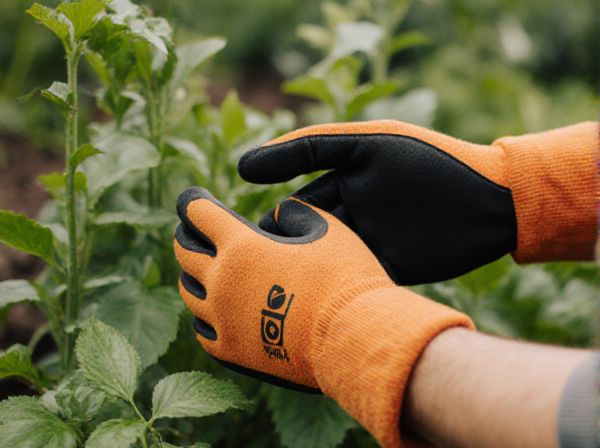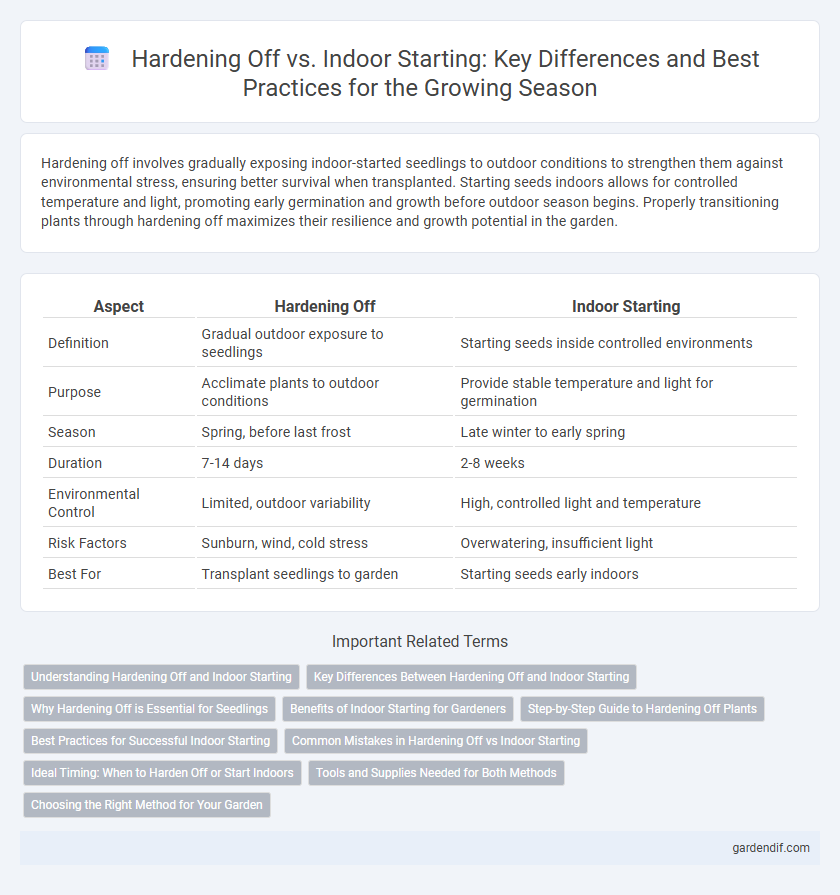
Hardening off vs Indoor starting Illustration
Hardening off involves gradually exposing indoor-started seedlings to outdoor conditions to strengthen them against environmental stress, ensuring better survival when transplanted. Starting seeds indoors allows for controlled temperature and light, promoting early germination and growth before outdoor season begins. Properly transitioning plants through hardening off maximizes their resilience and growth potential in the garden.
Table of Comparison
| Aspect | Hardening Off | Indoor Starting |
|---|---|---|
| Definition | Gradual outdoor exposure to seedlings | Starting seeds inside controlled environments |
| Purpose | Acclimate plants to outdoor conditions | Provide stable temperature and light for germination |
| Season | Spring, before last frost | Late winter to early spring |
| Duration | 7-14 days | 2-8 weeks |
| Environmental Control | Limited, outdoor variability | High, controlled light and temperature |
| Risk Factors | Sunburn, wind, cold stress | Overwatering, insufficient light |
| Best For | Transplant seedlings to garden | Starting seeds early indoors |
Understanding Hardening Off and Indoor Starting
Hardening off is the gradual process of acclimating indoor seedlings to outdoor conditions by exposing them to increasing sunlight, wind, and temperature fluctuations over 7-14 days to prevent shock. Indoor starting involves germinating seeds in controlled environments with optimal light, temperature, and moisture before transplanting seedlings outdoors. Understanding these steps ensures stronger plant resilience and higher survival rates during the transition from indoor growing to the garden.
Key Differences Between Hardening Off and Indoor Starting
Hardening off involves gradually exposing outdoor seedlings to natural sunlight, wind, and varying temperatures to strengthen them for transplanting, while indoor starting prioritizes controlled conditions like consistent warmth and light to optimize early growth. Hardening off reduces transplant shock by conditioning plants to environmental stressors, whereas indoor starting accelerates germination and initial development in protected settings. The key difference lies in hardening off's role as a transitional phase for outdoor survival compared to indoor starting as an initial growth strategy in a stable environment.
Why Hardening Off is Essential for Seedlings
Hardening off is crucial for seedlings because it gradually acclimates young plants to outdoor conditions, such as fluctuating temperatures, wind, and sunlight, which indoor environments cannot replicate. This process strengthens cell walls and reduces transplant shock, significantly improving survival rates and overall plant health. Without hardening off, seedlings started indoors risk suffering from stress and stunt growth when exposed to harsher outdoor environments abruptly.
Benefits of Indoor Starting for Gardeners
Indoor starting provides gardeners with greater control over temperature, humidity, and light, ensuring optimal conditions for seed germination and early growth. This method allows for an extended growing season by giving plants a head start before transplanting outdoors, reducing stress caused by environmental fluctuations. Early indoor starts also improve seedling vigor and increase the likelihood of successful garden yields.
Step-by-Step Guide to Hardening Off Plants
Gradually expose indoor-started seedlings to outdoor conditions by increasing their time outside each day over 7 to 10 days to reduce transplant shock. Begin with a few hours in a shaded, sheltered spot, then slowly extend exposure to direct sunlight and wind. This step-by-step hardening off process strengthens plant resilience, ensuring healthier growth and higher survival rates in the garden.
Best Practices for Successful Indoor Starting
Successful indoor starting requires maintaining consistent temperatures between 65-75degF and using grow lights that provide 14-16 hours of light daily to replicate natural sunlight. Seedlings thrive in well-draining, sterile seed-starting mix and benefit from gentle airflow to reduce damping-off disease risk. Gradually acclimating seedlings by hardening off outdoors for 7-10 days before transplanting strengthens them for garden conditions.
Common Mistakes in Hardening Off vs Indoor Starting
Hardening off mistakes often involve exposing seedlings too quickly to outdoor conditions, causing shock and stunted growth. Indoor starting errors typically include inadequate light and overwatering, leading to weak, leggy plants. Both methods require careful attention to gradual acclimation and consistent care to ensure healthy seedling development.
Ideal Timing: When to Harden Off or Start Indoors
Hardening off seedlings should begin 1 to 2 weeks before transplanting outdoors, ideally when daytime temperatures reach between 50degF and 70degF to minimize stress. Indoor starting is optimal 6 to 8 weeks before the last expected frost date, allowing seedlings sufficient growth while avoiding overcrowding under artificial light. Choosing the correct timing for either method ensures stronger plants and higher survival rates during seasonal transitions.
Tools and Supplies Needed for Both Methods
Hardening off requires essential tools such as a cold frame, plant trays, and protective covers to gradually expose seedlings to outdoor conditions. Indoor starting relies on grow lights, seed-starting mix, heat mats, and humidity domes to create a controlled environment for seed germination. Both methods benefit from quality seed trays, watering cans, and temperature monitors to ensure optimal growth and healthy plant development.
Choosing the Right Method for Your Garden
Hardening off involves gradually exposing indoor-started seedlings to outdoor conditions, which strengthens plants and reduces transplant shock, making it ideal for cold-sensitive species. Indoor starting gives gardeners control over temperature and light, allowing early germination and faster growth for crops like tomatoes and peppers. Choosing the right method depends on your local climate, plant type, and garden schedule to ensure optimal growth and healthy transplant success.
Hardening off vs Indoor starting Infographic

 gardendif.com
gardendif.com